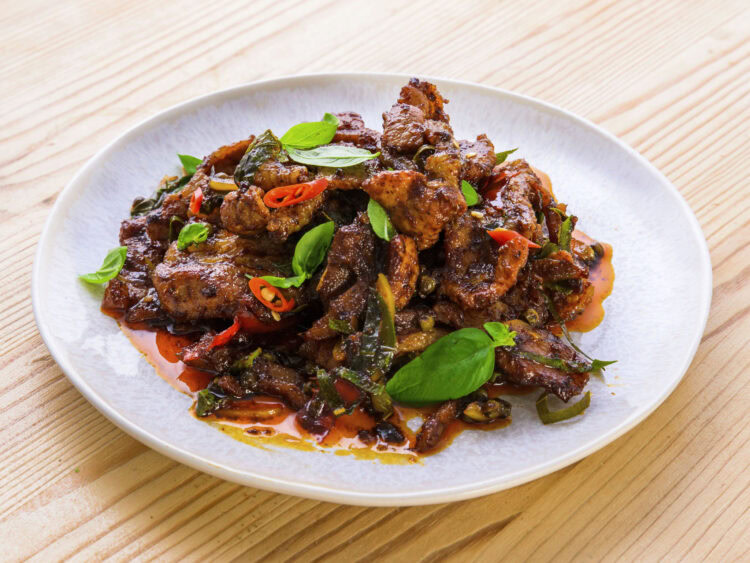As soon as the red curry paste hits the shimmering oil, a fragrant cloud rises. Diners sitting street-side lean back, their eyes already watering.
Phat Phet makes its presence known from the very first bite. The meat is coated in a chili paste so intense that even Bangkok’s seasoned commuters keep a handkerchief close by.
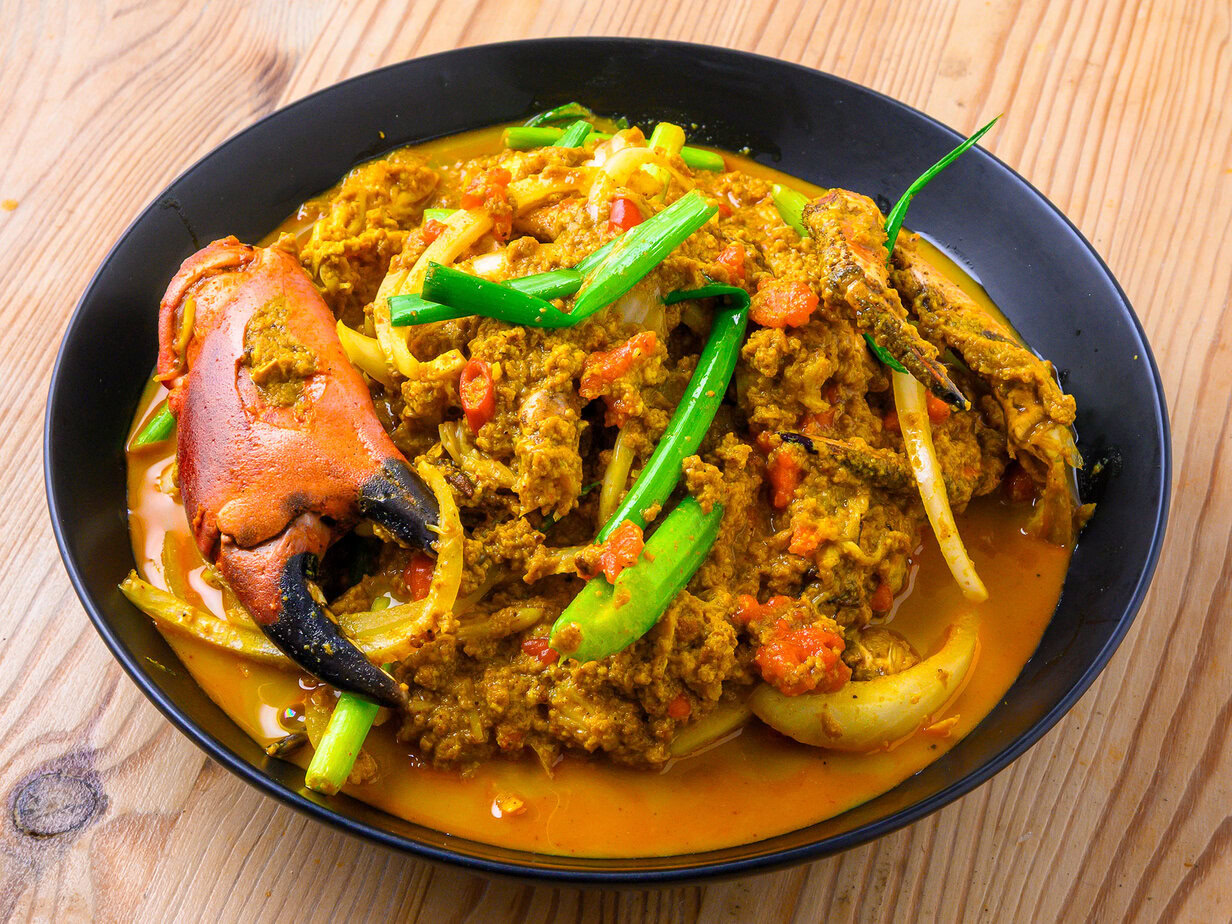
Born from the “อาหารป่า” (ahan pa, “forest cuisine”) of rural hunters, the dish left tin-roofed canteens for chandelier-lit bistros without ever losing its swagger. Old-timers insist: authenticity isn’t about a jumble of vegetables or drowning everything in coconut milk, but about three things—stripped-down ingredients, searing heat, and the wild aroma of fresh herbs.
From Central Thai Forests to Shared Tables
Chilies arrived in Siam in the 17th century with Portuguese traders, sparking a revolution in local curry pastes.
Hunters roaming the forests of central Thailand quickly learned that pounding these fiery new pods with lemongrass, galangal, and shrimp paste masked the strong flavors of wild boar, venison, or frog.
Phat Phet soon established itself as one of the original “game tamers”: a dry-fried curry where thin slices of meat perfume a mountain of rice. Unlike a tom saap soup, which highlights chili and sourness,
Over the centuries, the dish became a social benchmark for roet jat-jat (maximum flavor), often served as a drinking snack (กับแกล้ม) with an ice-cold beer and rowdy conversation. In village kitchens, it was also a budget-saver: a ladle of concentrated paste could season a whole wok, stretching the family budget without sacrificing intensity.
Traditional Ingredients & Technique
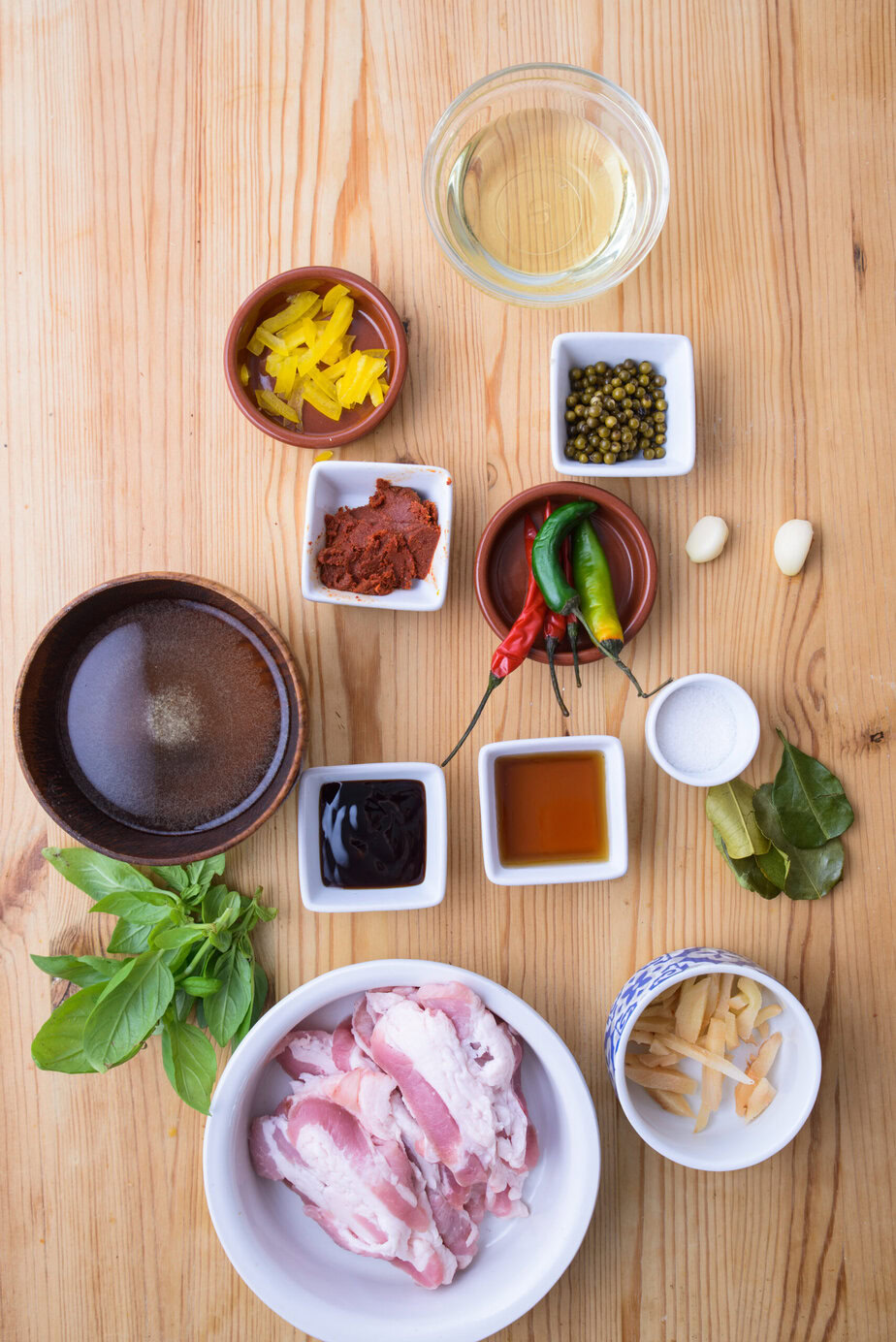
Every proper Phat Phet starts with a red curry paste. To keep it authentic, it’s made from:
- dried red chilies (often spur chilies) for heat;
- lemongrass, galangal, and makrut lime zest for citrus notes;
- garlic and shallots as the aromatic base;
- coriander and cumin seeds for warmth;
- black peppercorns;
- and finally, a spoonful of shrimp paste.
This concentrated paste is fried (never just warmed) until the oil separates and the kitchen fills with a chili haze.
Only then does the cook add a single protein: pork belly, maybe wild boar, but definitely not a surf-and-turf mix. Vegetables are few and carefully chosen: thinly sliced bamboo shoots or quartered Thai eggplants, rarely both. The forest signature comes from the herbs tossed in at the end: clusters of green peppercorns, julienned krachai root, torn kaffir lime leaves, and a handful of Thai basil.
The final texture must pass the local “nam kluk klik” test: a glossy oil that clings to the meat instead of drowning it. Coconut milk, if used, is mostly to loosen the paste. If the paste is undercooked, it tastes raw; add too much water and the flavor fades. Mastering that narrow path between burnt and watery is the rite of passage for anyone hoping to make credible Phat Phet.
Regional Variations
Travel a hundred kilometers and the recipe changes noticeably. In the central plains, a subtle touch of coconut cream and a pinch of palm sugar round out the edges, while bamboo shoots or marble-sized Thai eggplants add crunch.
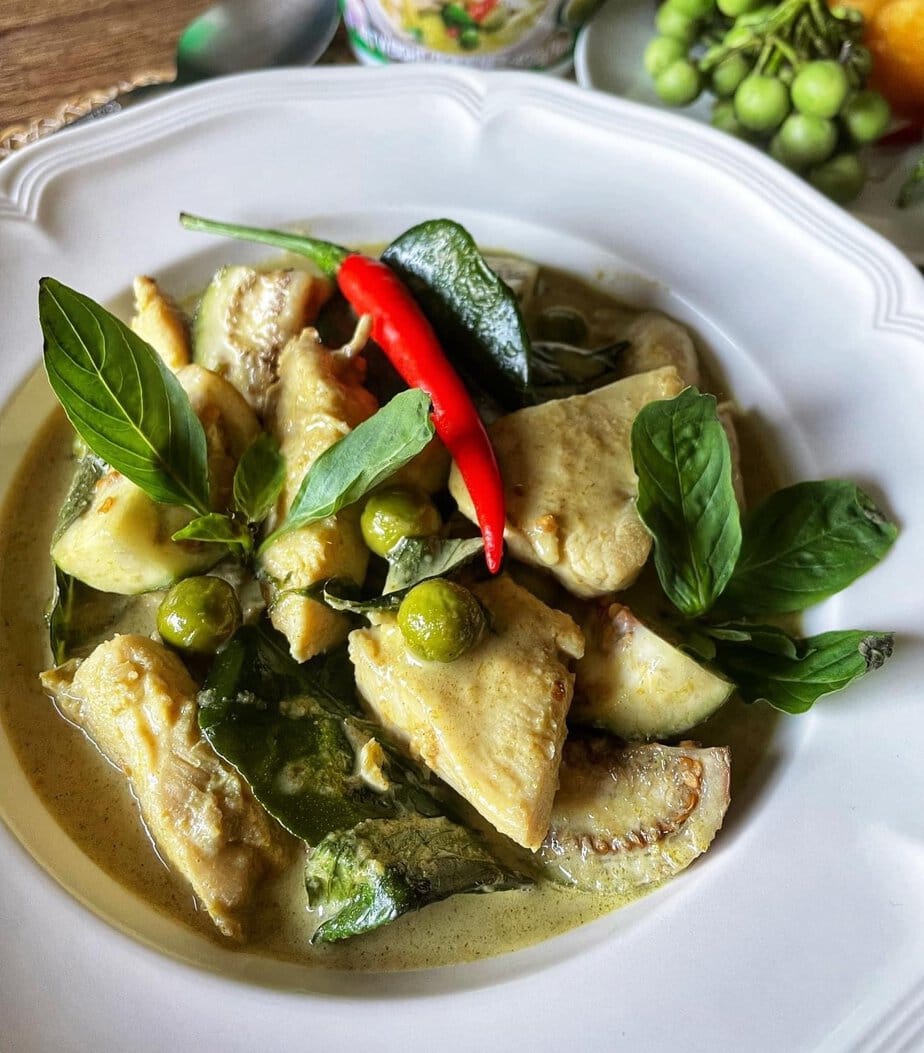
Head south, where Malaysian influence is strong, and turmeric turns the paste golden: the sweetness disappears, the heat ramps up, and the wok sizzles with Phat Phet Sataw, where big shrimp and pungent “stink beans” announce their arrival before they even hit the table.
Go northeast to Isan: cooks swap basil for peppery bai yiraa, add pickled bamboo, and sometimes a dash of fermented fish (pla ra). Across the country, game versions still pop up at roadside restaurants “อาหารป่า”: wild boar with extra krachai or frog legs glistening in red oil. Everywhere, two things remain: heat that brings tears and a cloud of herbal aromas.
Serving & Pairings
The reward for braving Phat Phet’s fire is how every blazing bite blooms over a bed of fluffy jasmine rice, chased by a bottle of ice-cold beer.
Today’s chefs experiment with venison or even plant-based substitutes, but they still honor the holy trinity: chilies, herbs, and discipline. Take up the challenge. From the first bite, sweat beads on your temples: you’re tasting four centuries of Thai ingenuity, one peppercorn at a time.
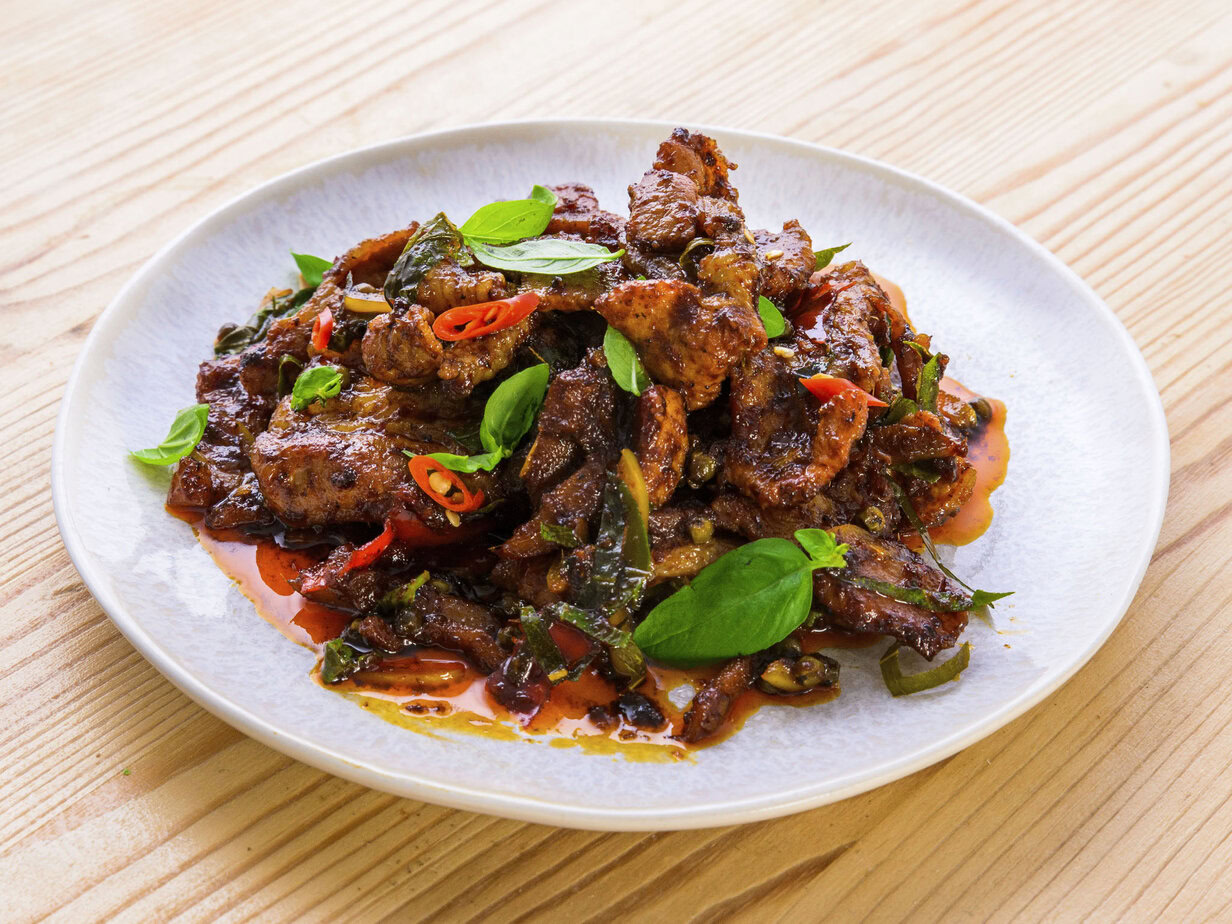
Equipment
Ingredients
- 150 g wild boar skin-on, sliced paper-thin; if unavailable, use pork belly
- 1 tablespoon Thai garlic peeled, lightly crushed; use half as much if using regular garlic
- 1 tablespoon red and green bird’s-eye chiles mixed, coarsely pounded
- 3 tablespoons vegetable oil
- 1 tablespoon Thai red curry paste
- 60 ml chicken stock
- 1 teaspoon sugar
- 2 teaspoons fish sauce
- 2 teaspoons oyster sauce
- 100 g krachai (fingerroot) julienned; substitute galangal if needed
- 2 clusters green peppercorns fresh, cut into 2 cm lengths
- 1 small Thai red chile sliced on the bias
- 1 Thai yellow chile sliced on the bias
- 5 leaves makrut lime leaves very finely shredded
- 1 handful Thai basil leaves plus extra tips for garnish
- Sea salt to wash the meat
- Steamed rice for serving
Instructions
Preparation
- Rub the wild boar with salt to tame any gamey aroma; rinse thoroughly and drain.150 g wild boar, Sea salt
- Pound the garlic and bird’s-eye chiles together into a coarse paste.1 tablespoon Thai garlic, 1 tablespoon red and green bird’s-eye chiles
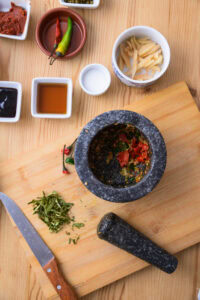
- Heat the oil in a wok over medium heat, add the boar, and stir-fry just until the surface firms up, pouring off any rendered fat if needed.3 tablespoons vegetable oil
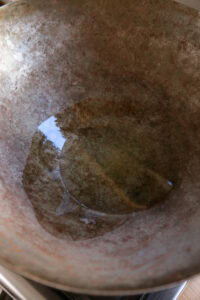
- Stir in the red curry paste and fry until fragrant.1 tablespoon Thai red curry paste
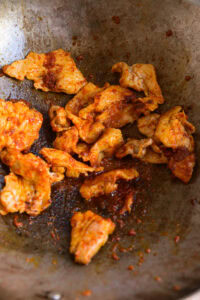
- Add the chicken stock, sugar, fish sauce, and oyster sauce, then mix well.60 ml chicken stock, 1 teaspoon sugar, 2 teaspoons fish sauce, 2 teaspoons oyster sauce
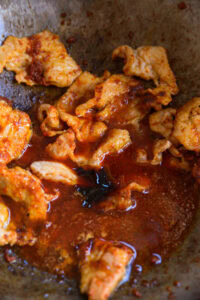
- Add the krachai and green peppercorn clusters; stir-fry over high heat until the liquid is almost evaporated and the paste clings to the meat.100 g krachai (fingerroot), 2 clusters green peppercorns
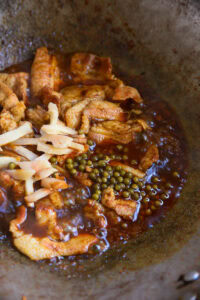
- Remove from the heat; fold in the red chile, yellow chile, makrut lime leaves, and Thai basil.1 small Thai red chile, 1 Thai yellow chile, 5 leaves makrut lime leaves, 1 handful Thai basil leaves
- Plate and garnish with extra basil tips; serve hot with steamed rice.Steamed rice
Notes
- Rubbing boar with coarse salt such as Guérande sea salt (not table salt) is a traditional trick to mellow its pronounced aroma.
- Keep the wok fairly dry; classic phat phet should be glossy and coating, not saucy.
